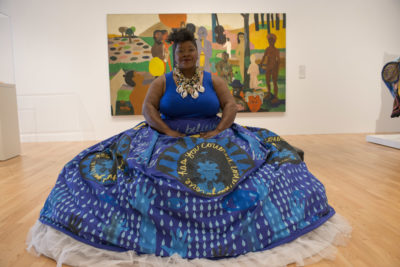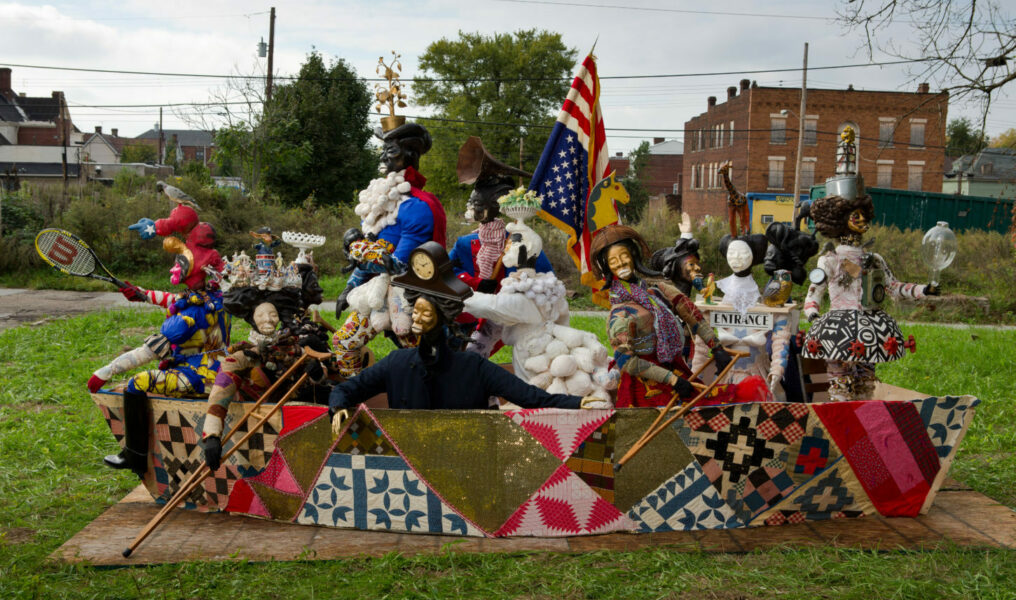Hanging at New York's Metropolitan Museum of Art, Emanuel Leutze's 12-by-21-foot "Washington Crossing the Delaware" is a proud, imposing painting, framed in a brilliant gold. Famous for not only its size but its portrayal of the glory of the American revolution, it features a valiant George Washington on his way to achieve a great military victory against Hessian troops, a victory that would aid in the creation of a country dedicated to serving all of its citizens. Or, at least, that's the story it tells to some. When Pittsburgh-based artist Vanessa German sees the work, she doesn't only see its intended narrative, she observes what that storyline is leaving out, too. Specifically, the full truth.
"If you ask the museum, they say that it's the most famous painting in America. It's this very heroic image of Washington crossing the Delaware in ice, this illuminated background; and there's the figures in the boat, they're supposed to represent all these cultures," German said. "There's a Native American person, a black person, a woman, and it's this really heroic, romantic lie about that war, the man, the time."
For German, the painting is one of many examples of a theme that is part of a much greater pattern that presents itself not only in the American art landscape but in the broader American culture as a whole: the prioritization of white stories and histories above others, false or not. And German says that, among other things, a primary consequence of perpetuating that racist pattern is the formation of inaccurate narratives in people's minds surrounding history and about who holds value in today's society. In fact, a re-evaluation of that more than century-old image became the focus of her latest exhibition, "Miracles and Glory Abound," now featured at the Flint Institute of Arts through April 20.
German said that when creating the piece she re-examined how she was taught history as a young girl and how pieces like the original "Washington Crossing the Delaware" made her feel.
"I think about the stories that I was told as a little, black, strange, artistic child growing up in Los Angeles about America and about what made America and about who made America, and I would experience the sort of trajectory of that story and the people who looked like they were in that story and the world that I was in," German said. "It looked like white people made America. [That] white people are safer, healthier, smarter, richer, more beautiful — they're just everything. … I'm a black, gay woman on this land and I was never actually supposed to have liberty."
German added that one can trace that narrative back to "these early romantic, heroic, sometimes very specific works of art that affirm and uplift and sort of solidify this narrative of these heroic, visionary, hyper-masculine white men that made America," and decided with her piece to visually, physically and spiritually flip that narrative.

Vanessa German in Avery Court, Wadsworth Atheneum Museum of Art, Hartford, CT, 2016. Photo: Allen Phillips / Wadsworth Atheneum Courtesy of the artist and Pavel Zoubok, Fine Art, NY
Reimagining Washington
For one entering the gallery housing German's sculptural installation at the FIA, German's work brings with it the scale of Leutze's original piece and then some. As if sucked into the painting itself, viewers enter a space where a three-dimensional Washington leads a similarly positioned crew forward across what can be assumed is the Delaware. The Washington figure, in this case a standalone piece part of a greater whole titled "LaQuisha Washington Crosses the Day Aware," along with everyone featured in the exhibit, is black and female.
"When I say female, I mean femme, I mean trans, I mean presenting intentionally as, that's what I mean," German said. "… So, thinking about not just blackwashing history, how history is often whitewashed, not just taking a thing that exists and making the figures in it black, but doing that and doing it with deep intention."
That intention, German said, centers around thanks, because for her, the creation of the work was "an act of love."
"So, it's not just the Washington figure, it is a single mother figure and it is a single mother figure who is carrying her child with her," German said. "Because I live in a world where everything around me would be different and healthier and … would have the spirit of almost edgeless abundance if people had the capacity to know how remarkable they are, and what is within them, and the sort of reach of humanity that exists in them because they recognize it reflected all around them."
But as loving as her intention is toward the groups of people highlighted within her installation, German's reimagination is also a direct confrontation of the lie perpetuated in Leutze's original work, too. That confrontation is well-summarized in a written piece by Holly Bass titled "The Evidence of Things Not Seen" that accompanies German's work in an exhibit-specific booklet.
"She inserts and asserts her Blackness, her womanness, her multivalent queerness, into this ongoing American narrative and asks us to consider the birth of this nation, a mythology of chopped cherry trees and founding fathers lying through wooden teeth," Bass writes. "The artist has said she wants to do 'violence to the lie.' What she means in part is the lie that the violence in Black communities is somehow a result of Blackness itself, and not centuries of systemic terrorism meted out against Black people. Lies against Black beauty, the sanctity of Black life, Black joy."
However, although German's work is a confrontation of that lie, she said that it's "not a direct answer."
"There is a reincarnation of a boat, of the George Washington figure, but the boat is floating on a skirt of water that tumbles off of the back of a little black girl. And she's carrying that whole boat forward and she looks like she's marching on water in the figure, but it's not just that," German said. "Then there's also the layers of the fact that you see it's almost as though the installation exists in a fictional city park and you see the monument, you see the little girl figure, but then you also experience the wonder of the lookers."
Surrounding the boat are sculptures of people each experiencing the monument in their own way, some are weeping, others point, while others still flip a literal bird at viewers. When asked how she came to call the work what she did, German said it's a play on a phrase made famous during the 2016 presidential election.
"… It's called 'Miracles and Glory Abound' on purpose. It's a tangle and twist and a reassertion of a phrase that is actually very violent to me which is 'Make America Great Again,'" German said. "And so, it is reaching more toward what Lincoln would call the better angels among us to say, 'No, miracles and glory abound.' Which is reaching toward the future, as opposed to 'Make America Great Again' which is asking you to cull through some sort of past of myth. A past of theater almost, the theater of America, to find something that was great, but there's no going back.
"There's no going back to that," German continued. "There's no going back to a time where as a black woman I was never supposed to have freedom, resources or liberty. So, it's playing on this, it's functioning on the spiritual plane, but also a political and cultural plane right now. And I think about [how] I just got back from Charlottesville a little while ago and went to Water Street where a young man felt like it was his sort of patriotic duty to run through a crowd of people who thought differently than him."
Creation of a Power Figure
To someone unfamiliar with German's larger body of work, the significance that each person depicted in her installations is something known as a power figure might not be immediately clear, but it's a piece of knowledge that adds another greater layer of depth to "Miracles and Glory Abound." Each presented figure within the greater installation is a standalone sculpture that carries its own meaning and is constructed from seemingly everyday objects. These objects have been carefully hand-chosen by German to not only achieve a desired aesthetic look, but to impart a deep emotional and spiritual significance. In an essay titled "Inherent Magic," author, poet and artist Daniel Simmons related German's sculptures to the West-Central African nkisi, plural minkisi, or "spirits, or objects that spirits inhabit."
"Like the traditional makers of nkisi, who used various materials available to them, such as bones, nails, pieces of mirrors, and herbal potions to infuse magic into the objects, German also uses things she finds readily available," Simmons said. "She incorporates objects that have various personal meanings from her life and experiences. Objects of real significance from childhood found abandoned in the community, as well as objects that have other personal and traditional cultural meaning for everyday women and people of color, all become products of spiritual, emotional and aesthetic infusion to be attached to or embedded in the sculptural housings made in the image of Black women."
Simmons also mentions in the written piece that though German didn't specifically reference minkisi in the creation of her pieces, it is something that occurs naturally, and the "revelation made her work all the more powerful to me."
"This seeming historical reference was her honest, innate magical 'juju' revealing itself and not a homage to the traditional tribal works that are found in museums and private collections," Simmons said.
Beyond the items comprising the sculptures, meaning is imparted also through hand-made packets or beads that adorn the work and carry inside of them intentional messages.
"I call them different things; I say that there's an incarnation of them. Depending on where I am and how averse people are to different spiritual language, I will name them different things — but they're swaddle beads, prayer beads or power beads," German said. "They have words inside of them. Sometimes, people will send me people's names and send me language and I will write them out on a big roll of butcher block paper and just cover it and then cut them into pieces and it goes inside of them."
German said, too, that this is a practice evidenced in a variety of cultures across the world.
"It's like Native Americans [who] had medicine packets and so did Haitians and Africans. It's a very old original human technology of sacredness, to wrap something up that's sacred and to keep it close to your heart, to wear it on your body or to put it in the earth," German said. "That's a way that human beings have spoken a language of sacredness across the entire earth."
Defining Beauty and Sacredness
When examining the work, it's clear that German has a specific focus in the creation of power figures that represent black women both straight and across the LGBTQ spectrum. That focus seems to stem from, at least in part, the attempt to partially fill the disproportionately huge vacuum that exists surrounding black female beauty in American society. German, who grew up in Los Angeles and attended school with now famous actors, said that the unrealistic Hollywood beauty standard was solidified in her mind very early on.
"I went to the Los Angeles Performing Arts Conservatory, and you knew who were aesthetically pleasing children. You knew who that was, you knew who they wanted to be on Saturday morning cartoon commercials, like which child sells you Wonder Bread. I started to notice as a child that I never saw happy black people on TV commercials or black families together," German said. "… And so, I grew up not having incarnations of black joy, black happy families and a diverse black beauty because I grew up when there had been some black models, but the features of those models fell in line with this one percentile of human beings that look a certain way. That's the world I grew up in, where you didn't see your joy reflected back to you in your face."
At the same time, as a child in the '80s living across the street from a halfway house called Gay and Lesbian Adolescent Social Services, German said that she was very early on introduced to a world not bound to heteronormativity. There, she formed a crush on a young black girl who was a skateboarder — a significant memory because that identity, German said, was exceedingly rare.
"She was so rare, and she was a good skateboarder," German said. "And we would go to Santa Monica Beach and I would look for black surfers and you wouldn't see that. Where would you see black people soaring and thriving in these ways that weren't like males in sports? … That's why Debi Thomas was a huge deal."
And when German's family eventually moved to Loveland, Ohio, German said there were even fewer examples of identities like those present. In fact, she was one of two black families in her new town where she was not exempt from dealing with blatantly racist attitudes.
"It was rare to be addressed with a sense of the fact that my being as a human being, as an earthling, is honorable and beautiful the same way that maple trees and sycamore trees and redwood trees; their beauty just stands; it just is," German said. "It took a long time to be able to have experiences outside of my own sacred time where I had a reflection of the is-ness that your beauty just is. That you are remarkable and you just are and you will not be repeated. Your life is now and it is beautiful and your body stands. I think all of those ways of knowing and seeing and honoring your is-ness are connected so deeply to your deep health, not disregarding your body because everybody else disregards your body and your organs. It's not just the aesthetic beauty it's the beauty of existing."
Today, it's clear when chatting with German that she has a much deeper appreciation for not only her own being but for others that's far greater than was ever intended by America's Founding Fathers. It's unmistakable, too, that her exhibit highlights this appreciation and unabashedly upholds a too-often obscured and diminished narrative of black beauty and power. German emphasizes, too, that the many messages present in the work, though they definitely hold a specific meaning for her as its creator, can certainly change depending on the person attending and experiencing her work. And in fact, she hopes that's the case.
"It's an ingestion that isn't merely aesthetic. It's not just that you're looking at the color blue, right? And then what is trying to diagram that experience for a human being who could have come from Vietnam to live in Flint, that's not [possible]," German said. "[There's] no singular message because I think that, for me, if there's any hope, it is that people would come into the room, you know, to be honest. Be in the room so you move around it and be with it. There's a bench in there, sit down. Be there."
See "Miracles and Glory Abound" at The Flint Institute of Arts in the Henry Gallery through April 20, 2019. The Institute is located at 1120 East Kearsley St. in Flint. 810-234-1695. flintarts.org.










